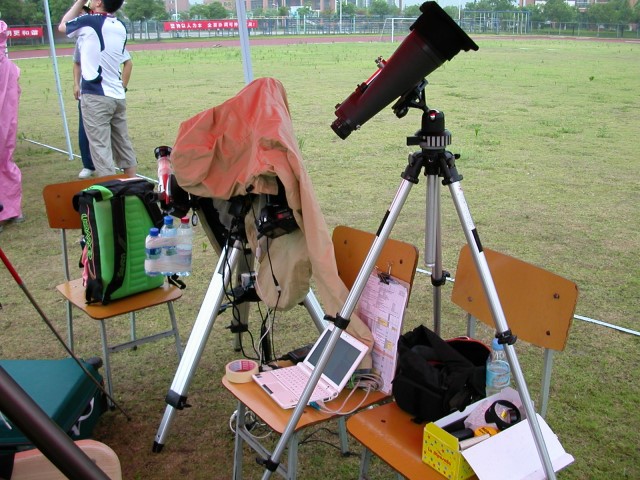My only image of the eclipse, during the exit partial phase, between the clouds that filtered the light. Technical
data: Canon EOS 5D, RAW, 100 ISO, Pentax 75 apo refractor, focal length
500 mm, f/6.7, exposure 1/15 s, glass solar filter, h 2.14.17 UT.
Illuminance measurements
The only scientific measurement
possible during the eclipse was the meteorological observations.
Unfortunately the heavy rain turned off my temperature and relative
humidity gauge, and the only working instrument was the luxmeter.
During totality the illuminance was very low, down to a value of 0.1
lux, the minimum value measured by the gauge. This is a lot lower
respect to the 2006 total solar eclipse, when a minimum of 4.1 lux was
reached. This is mainly due to the clouds that absorbed the daylight.
The totality zoom shows a non-symmetrical trend, with a brighter part
toward C3. This should be due only to the clouds thickness.
Here is the obtained graph, both in linear and logaritmic scale.


Images of the observing field
The
observing field was inside a bix complex of schools, totalling 10000
students, named "five schools". Our group observed from a football
field, that unfortunately filled up of water due to the heavy rain. The
organization kindly provided many gazebos that allowed us to protect
the telescopes. Here are some images.

Google map with the eclipse details for the observing field.

Our exact geographical position

My instruments: Pentax 75 on an equatorial mount and a 20x80 binocular

The instruments out for a while waiting for a hole in the clouds

Rain, rain, rain: all under the gazebo

Under the gazebo we hope for a better weather

Imaging the bad weather

The neighboring gazebo


Any football match would be suspended for heavy rain...

My instruments covered with a black bag to be protected from the heavy rain.

The only scientific instrument able to record the eclipse: the luxmeter.
Some days before... a circumhorizontal arc (CHA) over the Great Wall
Two days before the eclipse our group was visiting the Great Wall, and
we've observed a very nice circumhorizontal arc (CHA). Here are some
images. Thanks to our friends to note such an event: Lucio Furlanetto,
Alberto Dalle Donne, Enrico Finotto.
Every comment on the images is highly
appreciated, please write to
comolli@libero.it

























